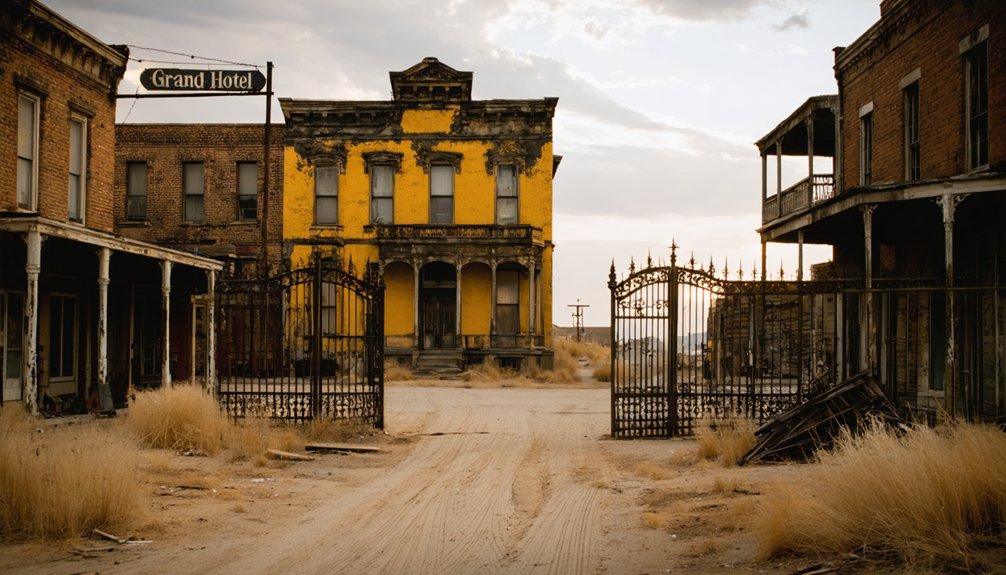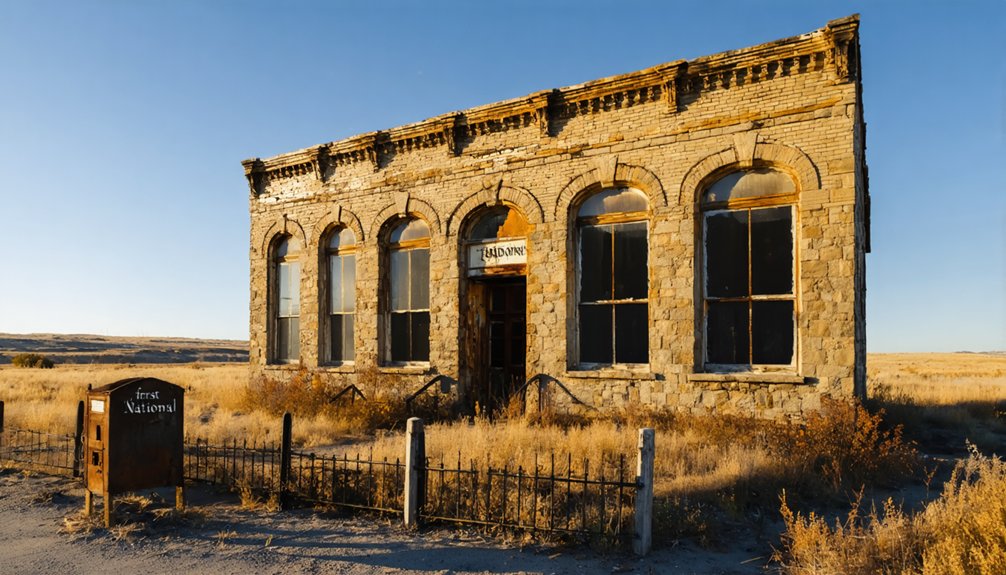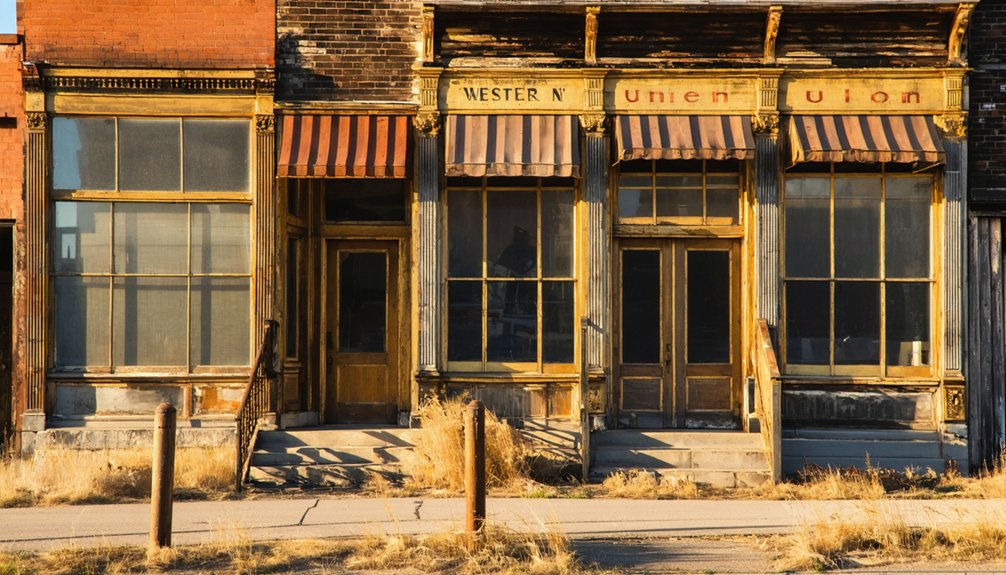You’ll discover Wealthy among South Dakota’s Black Hills ghost towns, where the 1874 Custer Expedition sparked a massive gold rush. In its 1870s heyday, the town bustled with miners working 12-hour shifts, while saloons and gambling halls dominated social life. Despite peak populations reaching 2,000 residents, dwindling precious metals and harsh conditions eventually emptied the settlement. The weathered ruins and preserved structures tell tales of frontier dreams and forgotten fortunes.
Key Takeaways
- Deadwood became one of South Dakota’s wealthiest ghost towns, reaching 25,000 residents during its peak mining era in the 1870s.
- The Black Hills gold rush created numerous wealthy boomtowns that later became ghost towns when precious metal deposits were depleted.
- Mining technology advancements initially brought prosperity but ultimately contributed to faster resource depletion and town abandonment.
- Preserved structures and ruins from wealthy mining operations remain as tourist attractions, showcasing the region’s rich historical heritage.
- Ghost towns like Galena housed over 2,000 residents during peak mining operations, with successful miners and business owners dominating society.
Origins in the Black Hills Gold Rush
While the 1874 Custer Expedition officially aimed to map and explore the Black Hills region, it inadvertently sparked one of America’s most significant gold rushes.
You’ll find that this discovery wasn’t just a lucky accident – it upended existing treaties and transformed the area forever.
The gold discovery in the Black Hills set off a chain of events that would reshape the American frontier.
A pivotal moment that forever changed the American West, setting the stage for conflict, settlement, and transformation.
Despite the Fort Laramie Treaty of 1868 recognizing this land as Sioux territory, prospectors couldn’t resist the lure of potential riches.
Even though initial findings along French Creek were modest, they were enough to draw thousands of fortune seekers to the region.
The U.S. government’s failure to keep miners out of this promised land created a powder keg of tension between settlers and Native Americans.
This conflict ultimately led to the Battle of Little Bighorn in 1876, where Custer met his demise.
By 1875, the Black Hills Gold Rush had begun in earnest, with countless prospectors making their way to Deadwood Gulch.
Life in a Mining Boomtown
In Wealthy during the 1870s, you’d spend your days deep underground or panning streams for gold, often working 12-hour shifts in dangerous conditions while dreaming of striking it rich.
After work, you’d join the crowds at bustling saloons and gambling halls, where miners mixed with entrepreneurs and outlaws in a fluid social hierarchy defined by luck and wealth rather than background. The discovery of gold in the region sparked a rush of prospectors following the historic Custer Expedition of 1874. The Powder Press maintains detailed archives documenting the daily life and struggles of these early miners.
If you’d a family, you’d struggle with the harsh realities of boomtown life, including unsanitary conditions, limited medical care, and the constant uncertainty of whether the gold would last long enough to secure your future.
Daily Mining Town Routines
Life in a South Dakota mining boomtown revolved around the demanding rhythms of the mines, where workers endured grueling shifts that often began before dawn.
You’d rise early to join your fellow miners, grabbing a quick meal before descending into the depths for your daily mining routines. The physical demands of the work shaped every aspect of your schedule, from meals to sleep patterns. After work, most men headed to the rowdy saloons to unwind and gamble away their earnings.
Between shifts, you’d navigate the bustling but basic amenities of town life. You’d have to deal with limited services, makeshift housing, and unreliable utilities. Unlike modern-day Sioux Falls’s diverse economy, these towns relied solely on mining success.
Still, you’d find comfort in the strong bonds formed with your diverse community of fellow miners. Despite the harsh conditions, you’d gather for community events that helped maintain morale, though the ever-present boom-and-bust cycle meant you couldn’t take prosperity for granted.
Saloons and Social Life
Saloons dominated the social landscape of South Dakota’s mining boomtowns, outnumbering every other type of business establishment you’d encounter.
You’d find these establishments buzzing with activity, serving as the heart of community gatherings where miners from diverse backgrounds forged strong bonds over drinks, card games, and live music performances.
The saloon culture wasn’t just about drinking – it shaped the town’s economic and social fabric. By 1877, the town’s population reached 3,000 as new businesses and entertainment venues opened their doors.
You’d see stages for entertainment, separate areas for wealthy patrons, and the iconic swinging doors that welcomed everyone from miners to merchants.
Like those chronicled in Boomtown Saloons, these establishments played a crucial role in preserving and sharing the stories of frontier life through the interactions of their diverse patrons.
While tensions occasionally flared in these often-lawless establishments, they provided essential spaces where you could exchange news, find employment, or simply escape the harsh realities of mining life through entertainment and camaraderie.
Hardships and Family Survival
Despite the allure of striking it rich, families in South Dakota’s mining boomtowns faced grueling daily challenges that tested their resilience.
You’d find yourself battling harsh Black Hills winters in overcrowded, makeshift housing while dealing with contaminated water sources and irregular food supplies.
The discovery of valuable deposits like mica and lithium provided alternative mining opportunities when gold production declined.
Family survival strategies often meant everyone pitched in – women managed households and nursed the injured, while children helped with domestic chores or mining support tasks.
Your family’s stability would hang by a thread with every mine accident or closure.
You’d rely on community networks to share resources during hard times, and you might need supplementary work like farming or trading to survive economic downturns.
Medical care was scarce, and the constant exposure to mining hazards meant your health was always at risk.
Family resilience wasn’t just important – it was essential for survival.
Economic Rise and Decline
You’ll find Wealthy’s economic trajectory mirrors many South Dakota mining towns, where early discoveries of gold and silver in the Black Hills spurred rapid development and population growth.
The town’s fortunes rose sharply in the 1880s as mining operations expanded, bringing railroads, businesses, and hundreds of hopeful settlers to the area.
Like other ghost town sites, the area eventually fell into various states of disrepair and abandonment as economic opportunities diminished.
Mining Drives Early Growth
The 1875 discovery of gold in South Dakota’s Black Hills region sparked an economic transformation that would shape the area for over a century.
Mining innovations quickly turned from simple placer operations to sophisticated hard rock extraction, particularly after George Hearst purchased the Homestake Claim for $70,000 in 1877.
You’ll find this investment led to rapid industrialization and the birth of numerous mining towns, with Lead and Deadwood at the forefront.
- Homestake Mine became North America’s largest and deepest gold operation
- Mining camps attracted diverse populations seeking their fortune
- Towns developed extensive infrastructure, including railroads and stamp mills
- Labor struggles emerged over land rights and mining impacts
- Secondary industries flourished, from timber operations to retail businesses
Boom to Ghost Town
Mining prosperity in South Dakota’s Black Hills region proved fleeting for many settlements that sprouted during the 1870s gold rush. You’d have witnessed towns like Deadwood swelling to 25,000 residents as mining technology advanced and cultural influences from across America converged on these frontier settlements.
But you couldn’t count on the boom lasting forever. When precious metal deposits dwindled and global market prices dropped, these once-thriving communities faced harsh realities.
Legal battles over mining claims drained resources, while inadequate transportation infrastructure isolated many settlements. As sawmills closed and mining operations ceased, workers and their families departed in search of new opportunities.
What remains today are silent reminders of an era when the promise of mineral wealth transformed the Black Hills landscape.
Daily Living and Social Structure

During Galena’s peak in the late 1870s, over 2,000 residents forged a diverse frontier community shaped by the Black Hills mining boom.
In Galena’s heyday, thousands of hopeful souls built a vibrant frontier society fueled by the promise of Black Hills gold.
Community dynamics reflected the era’s social hierarchy, where successful miners and business owners held prominence. You’d find a mix of prospectors, merchants, and former slaves building lives alongside “school marms” and saloonkeepers.
- Sarah “Aunt Sally” Campbell blazed trails as the first non-Native woman in the Black Hills.
- You’d gather for celebrations with music and shared meals during profitable times.
- Mining claims determined your social status and economic opportunities.
- Women ran boarding houses and businesses, breaking frontier gender norms.
- Daily life centered around the assay office, where you’d learn your ore’s worth and your fortune’s fate.
Physical Remnants Today
Today’s visitors to Galena encounter a mix of preserved structures and weathered ruins that tell the story of its mining heyday.
You’ll find several original mining camp buildings that local preservation efforts have saved through annual ghost town walks and community initiatives. These historic structures stand alongside deteriorating remnants showing signs of structural decay from decades of exposure to South Dakota’s harsh elements.
As you explore the site, you’ll discover historic artifacts scattered throughout, including old furnaces, vintage mailboxes, and abandoned railroad features.
While some buildings have collapsed into mere foundations, others remain standing but fragile. You’re encouraged to photograph these remnants but avoid climbing on structures to help preserve what’s left of this reminder of South Dakota’s mining past.
Historical Impact and Legacy

The Black Hills Gold Rush of the 1870s transformed South Dakota’s landscape as prospectors, merchants, and settlers flocked to emerging mining communities like Galena.
These frontier towns became epicenters of cultural influences and mining innovations that shaped the region’s development well beyond their brief existence.
You’ll find their legacy reflected in the infrastructure and demographic patterns that defined South Dakota’s early growth.
- Mining camps introduced diverse populations, including former slaves and pioneering women like Sarah “Aunt Sally” Campbell.
- Towns catalyzed regional development through new roads, railroads, and businesses.
- Local quarries and coal mines provided essential industrial materials.
- Communities established schools and social structures that laid foundation for future settlements.
- Historical societies preserve these towns’ stories through annual celebrations and educational programs.
Frequently Asked Questions
Were Any Famous Outlaws or Lawmen Associated With Wealthy, South Dakota?
You won’t find records of famous outlaws or legendary lawmen tied to this small Black Hills settlement. Unlike nearby Deadwood’s Wild Bill Hickok, Wealthy’s brief 1880s-era story lacks documented desperados.
What Native American Tribes Originally Inhabited the Area Before Wealthy’s Establishment?
You’ll find the area was originally home to various Sioux tribes, particularly the Lakota and Dakota bands, with some Cheyenne culture influence during the pre-settlement era of the northern plains region.
How Did Residents Get Medical Care in Wealthy During Emergencies?
While you’d expect modern ambulances, you’d have relied on horse-drawn emergency transportation to larger towns, kept basic medical supplies at home, and depended heavily on neighbors’ help during the town’s existence.
What Happened to the Cemetery and Burial Grounds After Abandonment?
You’d find the cemetery fell into complete disrepair without preservation efforts. Wooden markers rotted, nature reclaimed burial grounds, and time erased most traces of pioneer burial rituals from this mining-era site.
Did Any Major Fires or Natural Disasters Contribute to Wealthy’s Decline?
You’d be surprised how little we understand about fire incidents or natural disasters in Wealthy – the records are as empty as a ghost town’s Main Street on a windswept Dakota night.
References
- https://en.wikipedia.org/wiki/List_of_ghost_towns_in_South_Dakota
- https://openprairie.sdstate.edu/etd/4061/
- https://www.legendsofamerica.com/south-dakota-ghost-towns/
- https://www.sdpb.org/rural-life-and-history/2023-08-21/some-black-hills-ghost-towns-and-their-origins
- https://www.youtube.com/watch?v=Glucs_Rq8Xs
- https://aberdeenmag.com/2019/01/the-ghost-towns-of-brown-county/
- https://ruralresurrection.com/ghost-towns-mystic-south-dakota/
- https://www.blackhillsbadlands.com/blog/post/old-west-legends-mines-ghost-towns-route-reimagined/
- https://www.southdakotamagazine.com/galenas-ghosts
- https://www.ebsco.com/research-starters/history/black-hills-gold-rush



